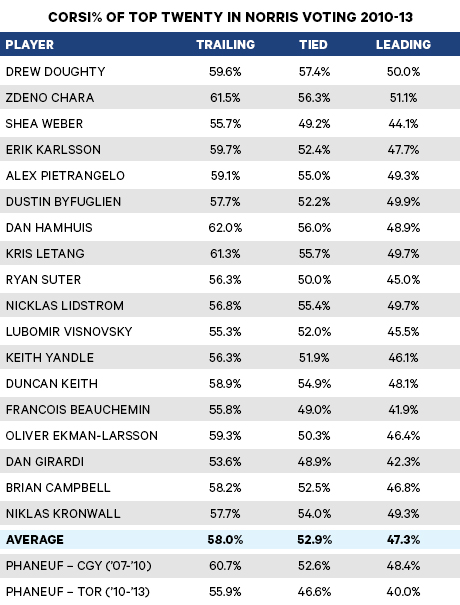When the Leafs sit down to negotiate a new contract with their captain, they’ll likely have to take the failings of their own brand of hockey in mind—at least where his so-called statistical decline is concerned.
I explained last week how the decline in Dion Phaneuf’s 5v5 scoring since he came to Toronto can be tied to the fact that he doesn’t play for a team that generates a lot of 5v5 shots anymore, and how that has made a significant impact on the volume of assists that he generates.
Programming alert: You can listen to Leafs vs. Bruins Saturday on Sportsnet 590 the Fan beginning at 7 p.m ET.
The inference that people draw when they see a player whose goals, assists and points have declined is that the player himself has declined. With Phaneuf, there’s reason to think that that’s not the case.
A lot of hockey comes back to the share of the shot attempts that a team gets. Everything flows from this. If you outshoot the other team 55-45, over time you’re going to score more goals than you allow. Players on the team getting 55 percent of the shots will score more points than players on the team getting 45 percent of the shots. In hockey analytics, this is generally measured with Corsi%, which is defined as a team’s shots, blocked shots and missed shots for/divided by all shots, blocked shots and missed shots in games played by that team.
As a general rule, better teams get a higher percentage of the shot attempts in a game. This seems to generally hold true with players as well – first lines tend to have a higher share of the shot attempts than second lines, and so on. If you look at the NHL over any reasonable period, say for skaters who played at least 2500 5v5 minutes between 2010 and 2013, the top end of the list is dominated by stars and people who play with stars.
I discussed last week that the rate at which Phaneuf’s team has generated shots with him on the ice has fallen since he moved from the Flames to the Maple Leafs – from 32.8 S/60 to 27.7 S/60 at 5v5 through the end of last season. This explains part of the decline in his assists at 5v5. Unsurprisingly, this shows up in his Corsi% as well. If your team isn’t generating shots, the puck is still somewhere on the ice and—rare cases like the neutral-zone trapping New Jersey Devils excepted—it usually means that it’s in your defensive zone, being fired at your goalie.
During 2007-10 in Calgary, the Flames got about 54.1 percent of the shots with Phaneuf on the ice at 5v5. This is an excellent number—in the 2012-13 season, just four teams managed a 5v5 Corsi% of 54 or better. New Jersey, with terrible goaltending, missed the playoffs. The other three (Boston, Chicago and Los Angeles) went to the conference finals, with Chicago beating Boston in the finals. During Phaneuf’s time in Toronto, his Corsi% has fallen off dramatically. The Leafs only got 47.7 percent of the shot attempts when he was on the ice between 2010-13, which is abysmal for a top-pairing defenceman.
I thought it might be interesting to look at the Corsi% when trailing, tied and leading for Phaneuf, in Calgary and in Toronto, and contrast it with the numbers for the best 20 defencemen in the NHL over the past three seasons, according to the Norris Trophy voting. (Regrettably, due to a data problem, P.K. Subban has been omitted.)
As you’ll notice, players tend to post better a better Corsi% when they’re trailing than they do when they’re tied. They also post a better Corsi% when they’re tied than they do when they’re leading. It’s a very well known effect in hockey analytics circles, referred to as “score effects.”
Something fascinating has happened with Phaneuf in Toronto. When Phaneuf was in Calgary, playing with a veteran team that was very strong in terms of possessing the puck and outshooting the opposition, his numbers look exactly like those of defenders the PHWA deem to have been the best of the past three years. If anything, they were slightly better. Since moving to Toronto, he’s seen his Corsi% when leading drop to slightly below the average for this group of defenders. His Corsi% when tied and leading has, however, absolutely collapsed relative to this group of players. That’s going to lead to fewer shots when he’s on the ice and fewer points—and we’ve seen from his numbers that that’s the case.
The critical question for the Maple Leafs is why? Why does Phaneuf look like a reasonable facsimile of the best defencemen in the NHL at 5v5 when his team is trailing, but not when they’re tied or leading? There are two potential answers.
First, perhaps Phaneuf has experienced some sort of a decline that affects him only when the Leafs are leading or tied. Second, it’s possible that the Leafs have changed the way they play when they’re leading or tied, and that has disproportionately affected Phaneuf.
The second explanation seems much more likely than the first.
Since Randy Carlyle took over, the Leafs have generated 55.2 percent of the 5v5 shot attempts when trailing with Phaneuf on the ice, 40.4 percent when tied and 36.6 percent when leading. It seems exceedingly unlikely to me that a player would enter a period of decline that only shows up when his team is tied or ahead. If the decline in Phaneuf’s Corsi% is due to a tactical choice, then the Maple Leafs need to take into account that Phaneuf may not have the statistical profile of a number one defenceman due to the choices that they have made. It doesn’t mean that he’s not an elite defenceman, just that the way they’ve chosen to play produces different results.
Using data to address these questions in sports isn’t, as it’s sometimes portrayed, about finding a number that answers everything. Hockey doesn’t really work that way, at least with the data that’s currently available. Rather, it’s about generating better evidence, evidence that is as objective as possible, and then trying to draw reasonable conclusions from that evidence.
In Phaneuf’s case, I’m inclined to think that the Leafs’ tactics make his numbers look worse than he actually is. We can debate whether the Leafs’ tactics are sensible—I don’t think that you can build a Cup contender that plays the way they’re playing unless you have Sidney Crosby and Evgeni Malkin so it seems sort of pointless to me—but it seems more likely that their system results in Phaneuf generating terrible results than it does that Phaneuf is fine when trailing, but terrible when leading or tied.
If you’re playing a system that destroys a player’s numbers, it’s silly to blame the player for that. If the Leafs can secure Phaneuf for something close to his current cap hit of $6.5M, they’ve probably secured an excellent player, regardless of the fact that his Corsi% seems to suggest that he’s been in serious decline since coming to Toronto.




